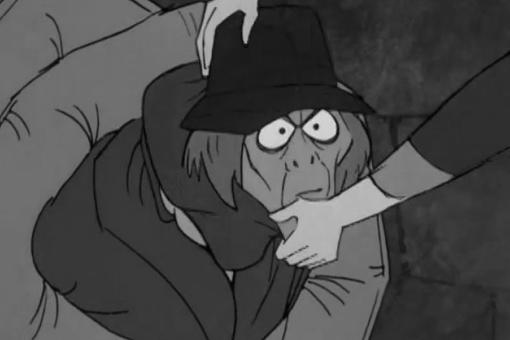Makes watching paint dry seem dizzying

Have you heard of the Pitch Drop Experiment? It’s the longest-running ongoing lab experiment EVER.
Pitch, like what they put on the hulls of ships, seems like a solid at room temperature. Even brittle. But it ain’t. It’s a very, very viscous liquid, 100 billion times more viscous than water.
To demonstrate this, Thomas Parnell, University of Queensland’s first Professor of Physics, made a thing. In 1927, he heated some pitch and poured it into a sealed glass funnel. After three years – I guess he wanted to make very, very sure it was cool – he snipped the end of the funnel off and waited. And waited. And waited.
It has taken eight to thirteen years for each drop to fall. It’s a demonstration, not a proper experiment, so it isn’t in an environmentally-controlled environment. Meaning, it makes faster progress when it’s hot out.
Nobody has ever seen a drop fall. Per the link above: “In the 86 years that the pitch has been dripping, various glitches have prevented anyone from seeing a drop fall.” I don’t know what ‘glitches’ happen outside computers, I merely repeat what I have read.
But you might see it! It has a webcam! The ninth drip fell in 2014, so only another two to eleven years to go on Tenth Watch.
I know what I’m doing this weekend. Have a good one!
March 19, 2021 — 7:16 pm
Comments: 6
Neanderthals buried their dead. With flowers.

You know I have a thing for Neanderthals. I read many years ago that they buried their dead with flowers. They knew because archeologists found flower pollen on top of the bones.
I didn’t realize there was doubt cast upon it subsequently. For example, because rodents sometimes carry flowers into their burrows in that cave. That fact astonished me, but then again it didn’t. I gave a pet mouse a flower once and she spent the afternoon sticking her whole head in it to sniff.
I digress.
They’ve found another burial and it again they found flower pollen and signs of digging. But they were more careful excavating this one.
Another win for muh bois.
p.s. all the current links in the sidebar of that New Scientist article linked above are about Coronavirus. I’m’a go read them. Some very interesting comments on that topic from readers in the thread below this one.
February 20, 2020 — 9:45 pm
Comments: 11
Looks like naugahyde

Behold, the highest-resolution images of the sun ever taken. Each of those knobbles is about the size of Texas. These are the first pictures from the brand new 12-foot Daniel K. Inouye Solar Telescope at the the National Solar Observatory in Hawaii.
But that’s just the beginning. NASA launched a probe in August of 2018 and the European Space Agency has another one going in February, both intended as long-term solar observatories. Among the questions: why is the atmosphere of the sun a million degrees hotter than the surface? They also hope to observe the sun’s magnetic poles flip, a thing it does every eleven years.
I’m personally hoping they can find some sun spots. I don’t want to eek out my old age in record cold.
Coronavirus update: numbers continue to climb in China while remaining curiously flat in other affected countries. One theory (observation, really) is that Asians are more susceptible. And men more than women, by about four to one. No, I don’t have any citations for that. It came across my Twitter feed and made me go hmmmm.
January 29, 2020 — 9:11 pm
Comments: 11
Scooby doo made flesh

Neat article about super realistic silicone masks. It isn’t that they’ve gotten better, it’s that they’ve gotten cheaper. Used to be, only a big movie studio could afford them. Now you can get one for under $1,000.
Still a lot of money, but worth it if you were something like a bank robber. Which might be the back story to this guy, who robbed sixteen banks. He was either old or wearing an old man mask.
Nice selection to be seen from these people, who seem to be charging $799 for they typical mask. Hair included.
Turns out, changing the subject, that it’s Squirrel Appreciation Day. My Twitter feed has been fluffy and useless all day.
January 21, 2020 — 8:29 pm
Comments: 5
That there’s a fox

I knew they’d bred foxes to be tame in Russia, but I didn’t realize it was part of a deliberate scientific study. They bred friendly foxes to friendly foxes and aggressive foxes to aggressive foxes and now (in a process they probably didn’t imagine when they started out sixty years ago) they’ve been able to sequence both genomes and compare.
There are about a hundred gene differences between the two groups of foxes, but they zeroed in on one gene in particular — one that is associated with with autism and Alzheimer’s in humans. That bit isn’t relevant, I just thought it was weird and interesting.
The thing I thought was cool: as the fox generations became friendlier, they developed things like white spots, floppy ears, curly tails. Physical characteristics we associate with domestic animals.
A NatGeo article about the study is here, which links to the actual study.
August 6, 2018 — 9:08 pm
Comments: 9
Heh. Neat.

The Natural History Museum is setting out to digitize 80 million specimens. Most of these are part of various herbariums (herbaria?), particularly the Hans Sloane Herbarium. Plant samples. You know.
The challenge is, most of this stuff is just plants pressed into albums. Not even glued, just pressed. You can imagine how hard it is to open and photograph that stuff without dropping bits all over the floor.
I don’t know if you can see it, but those little armatures holding the pages open? They’re made of Legos. Which makes perfect sense:
‘By making it completely out of Lego it is possible to have it ordered and shipped to almost anywhere, and the low cost makes it affordable to everyone. It is especially important for scientists in developing countries and students.’
To be honest, I’m surprised there doesn’t exist some special titanium-and-molybdenum super-sciencey chrome-plated lego-like but much more serious kind of building kit for projects like this.
Surprised and bitterly disappointed.
April 16, 2018 — 7:59 pm
Comments: 5
I gotta do my homework!

It’s the sixth and final week of my online microbiology course – finals due Sunday – and I ain’t done nuffink. It would be just like me to fail at the last hurdle, so I best get a move on.
This last material should be pretty easy, though — it’s all about the American Gut Project, a combination of crowd-funding and citizen science. Basically, you give them money, you give them a (ahem) sample, you get a detailed report of their findings, your data gets added to the giant rolling pool of gut data.
Four years, over 10K guts analyzed, $1.5M raised.
I suppose the cynical take is that you get played for a mug coming and going, but I love this idea and projects like it, I do. It’s like the people who told me “ZOMG 23-and-me is selling your genetic data to big pharma!” and I’m like “Whoa! That. Is. AWESOME!”
Anyway, their website is above. Their Fundrazr is here. Yes, there’s a British version. No, I haven’t signed up yet. No, you don’t have to touch the poop (you get a perfectly good swab sample from toilet paper). Yes, you can have your cat’s gut analyzed (good luck getting him to use toilet paper).
The idea is probably a lot more exciting after six weeks of studying gut microbes, but I’m pretty jazzed. I’m saving my pennies.
Good weekend, y’all!
addendum: I’m adding this to the main post so you don’t miss it. First, if you haven’t played with today’s Google Doodle, do. (hee hee! Googledoodledo!). I never heard of Oskar Fischinger before, but that music thingie is fun to play with. No direct link, alas, so it probably will be gone after today. ALSO, starting Monday at 11 PT, they’re doing the longest ever MST3K marathon on Twitch. Yes, classic episodes. Thirty eight of ’em. (Has anyone seen the new one? Is it as rubbish as it looks?).
June 23, 2017 — 7:11 pm
Comments: 32
More guts.

In the thread below, Feymangroupie asks “Wait, if everyone has pretty much the same baseline gut bacteria…” I’m’a stop you right there, FMG. Because everyone doesn’t have the same baseline gut bacteria, apparently, AT ALL. According to the intro video to this course, you likely only share 10% of your gut microbiome with the person sitting next to you. I have to assume “sitting next to you” includes people who live with you and share a large part of your diet.
It’s not just antibiotics that mess with your get critters, it’s everything you put in your mouth – every aspirin and ice cream and habanero pepper. But also, I assume, your own genetics, the microbes in your environment, the ambient temperature. I think. I guess. I’m only at Week 2.
The diagram above is from a very interesting video about childbirth. Turns out, there’s a good reason for those hours of labor: once the amniotic sac breaks, contractions swish babies around in mama’s vaginal biome until they get a proper dose. In European women, this includes a heaping helping of Lactobacillus which, among other things, helps baby digest milk.
Babies born by C-section don’t get this; their initial gut microbes appear to be derived (unhelpfully) from mama’s skin. They think (it’s still early days) that may account for some of the health problems C-section babies have for the first few years. They’re doing a huge study of this in Puerto Rico, where cesarean births outnumber natural births “for cultural reasons” (they didn’t go into it, but we can imagine what those are).
Uncle B sent me this timely link from the Daily Mail: a common diabetes drug apparently works not by affecting you, but by affecting your gut microbes.
He also sent me this link to OH MY GOD ADORABLE ERMINE IN A LOG!!!
And no. Nobody had Roger Moore in the DeadPool. He was 89?? Really???
May 23, 2017 — 8:44 pm
Comments: 18
Oh. That explains it.

Have you ever wondered why gut bacteria is such a hot topic at the moment? I know I have!
Wellll…in olden times, you studied bacteria by making a culture. You’d sterilize a needle, drag it across a toilet seat, wobble it across a petri dish full of nutrient agar or some shit, and a week later you’d have — several streaks of fuzz!
Then you could take a sample of that fuzz, put it under a pretty high-powered microscope, and you’d see — something that looked like a corkscrew, something that looked like a hotdog or something that looked like a basketball. Because that’s it; that’s all the different shapes that microbes come in.
And that’s about all you could do. You could try feeding some to a mouse, but that’s not very sporting.
A majority of important microbes — particularly gut microbes — won’t grow in a culture at all. We’ve been studying the ones that will. Turns out, e.coli isn’t a very numerous or important gut bacterium at all, it just LOVES to grow in a petri dish. Huh.
Easy DNA analysis is what changed all that. They can grind up poop samples and get a pretty good idea of what your intestinal rainforest consists of. Even better, they can look at the genes and tell what some of them do.
They can even culture more of the buggers, now that they can isolate strands and work out what they live on. Turns out, gut bacteria are madly picky eaters — which is why certain meals affect your guts fast and hard.
Week Two of my microbiome studies continues apace.
May 22, 2017 — 9:47 pm
Comments: 15
There are two kinds of websites in this world

There are sites that will describe this as “Aurora Caught by Hubble Space Telescope” and there are sites that will say “Something Weird is Spotted Coming Out of Uranus.”
This blog, for example, would never be caught making cheap double entendres about Uranus. This blog is alllllll about the dick jokes.
It is an aurora, like the ones we get (Jupiter and Saturn, too) and the brightest we’ve ever seen on Uranus, apparently. Uranus is hard to study because it’s a completely featureless frozen blue gas ball.
They used an ultraviolet doohickey built into Hubble to find this aurora — and interestingly proved that it moves with the rotation of the planet. They also managed to rediscovered the magnetic poles which have been missing pretty much ever since Voyager found them because, again, featureless blue gas ball.
Also, note rings.
Oh, hey, did you see the moon last night? Holy cow, was it huge! The news said it was going to be pink, but it was gold here. On the horizon, anyhow.
April 12, 2017 — 8:16 pm
Comments: 19












